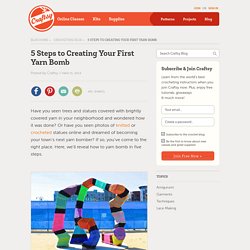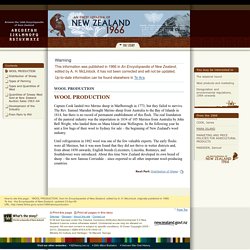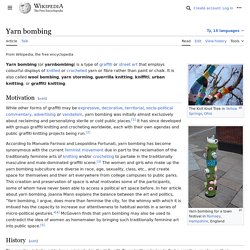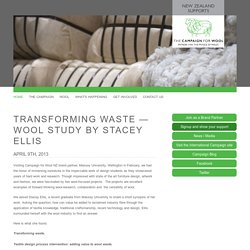

Felting - 3 Ways. Meet Google Drive – One place for all your files. Meet Google Drive – One place for all your files. Have you seen trees and statues covered with brightly covered yarn in your neighborhood and wondered how it was done?

Or have you seen photos of knitted or crocheted statues online and dreamed of becoming your town’s next yarn bomber? If so, you’ve come to the right place. Here, we’ll reveal how to yarn bomb in five steps. Interlead Appraisal Connector - Login. Espacio de almacenamiento y correo gratuitos de Google. Ir al contenido Iniciar sesión Crear una cuenta Tu versión de Internet Explorer no es compatible con Gmail.

Es posible que algunas funciones de este sitio web no funcionen correctamente. Pásate a un navegador más moderno como Google Chrome. La sencillez y facilidad de Gmail en todo tipo de dispositivos Crea una cuenta La bandeja de entrada de Gmail clasifica tus mensajes por tipo para organizarte mejor Crea una cuenta Habla con amigos en una videollamada, chatea con un compañero o llama por teléfono sin salir de tu bandeja de entrada Crea una cuenta. Google Slides - create and edit presentations online, for free. WOOL PRODUCTION. Warning This information was published in 1966 in An Encyclopaedia of New Zealand, edited by A.

H. McLintock. It has not been corrected and will not be updated. Up-to-date information can be found elsewhere in Te Ara. Captain Cook landed two Merino sheep in Marlborough in 1773, but they failed to survive. DigitalNZ. Wool - DigitalNZ. Not Your Grandma's Knitting: 20 Incredible Yarn Bombs. While certain types of permanent graffiti can be a very beautiful addition to an otherwise bland space, much of the time it's unattractive and a pain to remove.

Yarn bombing, however, is a completely different story. Yarn bombing. Yarn bombing, yarnbombing, yarn storming, guerrilla knitting, kniffiti, urban knitting or graffiti knitting is a type of graffiti or street art that employs colourful displays of knitted or crocheted yarn or fibre rather than paint or chalk.

Method and motivation[edit] While yarn installations – called yarn bombs or yarnstorms – may last for years, they are considered non-permanent, and, unlike other forms of graffiti, can be easily removed if necessary. Nonetheless, the practice is still technically illegal in some jurisdictions, though it is not often prosecuted vigorously.[1] While other forms of graffiti may be expressive, decorative, territorial, socio-political commentary, advertising or vandalism, yarn bombing was initially almost exclusively about reclaiming and personalizing sterile or cold public places.[2] It has since developed with groups graffiti knitting and crocheting worldwide, each with their own agendas and public graffiti knitting projects being run.[3] History[edit] 5 Most Amazing Yarn Bombings You Don't Want to Miss. Nothing brings a smile to my face like a yarn bombing.

Whether it’s a huge installation on a bridge or just a small one like a doorknob cozy, seeing everyday objects covered in yarn brightens my day instantly. Fiber artists like Olek and Magda Sayeg are practically yarn craft-household names in the world of yarn bombing, organizing some of the most famous fiber installations we know. Now, yarn bombings are now becoming so large in size that it often takes the cooperation of fiber artists and large organizations to stage the entire installation.
Photo via Yarn Bombing Los Angeles Craft and Folk Art Museum, Los Angeles From far away, you’d never know that all these colorful squares are actually crocheted granny squares. More than 500 crafters from around the world contributed to this specific project. Photo via Alicia Kachmar Mr. Yarn bombing statues is not uncommon, as we’ve seen from yarn bombings like the Rocky statue in Philly. How to Yarn Bomb: Tips & Tricks from a Pro.
Biotech Learning Hub. Consumer demand and new technology drives wool innovation Changing consumer needs and lifestyles are driving demand for new fabrics that are lightweight, comfortable and easy to care for.

The increasing range and functionality of synthetic fabrics has been meeting this consumer need and presenting a challenge for wool researchers. Developments in spinning technology and fabric construction together with growing understanding of wool’s structure have helped researchers respond to the challenge, and now a variety of innovative wool textiles are meeting consumer demand. Wool processing: fleece to fabric. Fleece Different breeds of sheep produce different types of wool, from very fine merino wool to much coarser crossbred wool.

Coarser diameter wool is more suitable for heavy apparel and carpets, while finer wool is used for high-quality apparel. The key properties that determine the use of wool are its diameter and the crimp. The crimp or the waviness of the fibre is different from breed to breed. In merino, it’s very fine – about half a millimetre spacing – but the crimp in crossbred wool is several millimetres long. Woollen processing. Biotech Learning Hub. Delivery / Kiwi made / Resistant materials - hard / Classroom practice case studies / Case studies / Resources / Welcome to Technology Online - Technology Online. Weeks 1 – 5: Basic skills and knowledge The class began with a theme of 'Buy Kiwi Made' and was asked to consider the statement "The New Zealand clothing industry is being flooded with cheap mass-produced clothing.

Creating our own unique cloth and turning this into garments with simple construction may provide us with an opportunity to compete. " Wendy had introduced dyeing to her Year 9 class the previous year, when she had organised teacher Merrilyn George to run a workshop on dyeing for them. A corner of the workroom has three deep sinks and overhead dyeing racks, so it was easy to set up a dyeing area away from fabrics, etc. Wendy found this a valuable way for a large class of students to learn how to dye safely, and based on this experience decided to incorporate dyeing into the Kiwi Made unit. Once they had learnt the basic skills of dyeing, the girls went on to try different techniques. Weeks 6 – 10: Production The class then started looking at producing their own material. Shikoba - Fashion steeped in values / Resistant materials - textiles / Technologists' practice case studies / Case studies / Resources / Welcome to Technology Online - Technology Online.
Transforming Waste — Wool Study by Stacey Ellis. April 9th, 2013 Visiting Campaign for Wool NZ brand partner, Massey University, Wellington in February, we had the honor of immersing ourselves in the impeccable work of design students as they showcased years of hard work and research.

Though impressed with state of the art furniture design, artwork and fashion, we were fascinated by two wool-focused projects. The projects are excellent examples of forward thinking wool-research, collaboration and the versatility of wool. We asked Stacey Ellis, a recent graduate from Massey University to share a short synopsis of her work. Asking the question, how can value be added to reclaimed industry fibre through the application of textile knowledge, traditional craftsmanship, recent technology and design, Ellis surrounded herself with the wool industry to find an answer. Here is what she found. Stacey Ellis. For more information contact: stak09@hotmail.com. Developing eco-friendly fabrics / Resistant materials - textiles / Technologists' practice case studies / Case studies / Resources / Welcome to Technology Online - Technology Online. Introduction Dr Sandy Heffernan is a senior lecturer in the Institute of Industry and Environment, part of Massey University’s College of Creative Arts in Wellington.
Natural dyeing techniques / Middle - Years 7–10 / Teaching snapshots / Resources / Welcome to Technology Online - Technology Online. Faced with teaching Soft Materials in a Hard Materials workroom, Technology teacher Demelza Cusens chose to see it as a challenge rather than problem. "I thought it was a perfect opportunity to change people's perceptions about Soft Materials and so I took it from the textiles manipulation standpoint. " Demelza Cusens Timetable changes meant Demelza would only see her Year 9 classes for five one-hour periods over ten days, so she also needed a context that would allow her students to complete their work within this time frame.